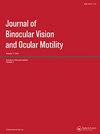The Effect of Refractive Amblyopia on the Frisby Stereotest
Q3 Medicine
Journal of Binocular Vision and Ocular Motility
Pub Date : 2022-08-19
DOI:10.1080/2576117X.2022.2106745
引用次数: 0
Abstract
ABSTRACT Purpose To identify the expected degree of stereoacuity measured by the Frisby Stereotest, in various degrees of unilateral refractive amblyopia. Methods A prospective investigation of 22 patients, with a clinical diagnosis of unilateral refractive amblyopia. All patients were aged 4–12 years and seen between February and November 2021. All patients were recruited to the study at their first return visit with new glasses as prescribed by our physicians, following a cycloplegic refraction. All patients had a full orthoptic examination including the near Frisby Stereotest, visual acuity assessment, an induced tropia test (ITT) using a 20 base-in prism. A fixation preference qualified as amblyopia for the purpose of this study. All tests performed are part of our routine examination. Results Regression analysis was performed on the data to identify a correlation between variables. We compared the Frisby scores with the maximum visual acuity difference between the eyes, the amblyopic visual acuity, the non-amblyopic visual acuity, and the spherical equivalent of the patients’ refractions. Analysis revealed a strong relationship between both the visual acuity difference and the Frisby score (r = 0.64, R 2 = 0.41), and the amblyopic visual acuity and Frisby score (r = 0.73, R 2 = 0.53). There was no relationship between the anisometropia based on spherical equivalent refractions (r = 0.03, R 2 = 0.0007). Conclusions Given the moderate-to-strong correlation noted between visual acuity and stereoacuity, we suggest that the Frisby Stereotest can be utilized to imply possible refractive amblyopia and allow earlier intervention which may lead to more successful outcomes.屈光性弱视对Frisby立体测试的影响
摘要目的确定Frisby立体视觉测试在不同程度的单侧屈光性弱视中的预期立体视锐度。方法对22例临床诊断为单侧屈光性弱视的患者进行前瞻性调查。所有患者年龄在4-12岁之间,就诊时间为2021年2月至11月。所有患者在第一次复诊时都被招募到研究中,按照我们医生的处方,在进行睫状肌麻痹屈光术后佩戴新眼镜。所有患者都进行了全面的矫形检查,包括近弗里斯比立体测试、视力评估和使用20个棱镜的诱导性斜视测试(ITT)。为了本研究的目的,一种被认为是弱视的注视偏好。所有测试都是我们日常检查的一部分。结果对数据进行回归分析,以确定变量之间的相关性。我们将Frisby评分与患者眼睛之间的最大视力差、弱视视力、非弱视视力和屈光度的球面等效值进行了比较。分析显示视力差异与Frisby评分之间有很强的相关性(r=0.64、R2=0.41),以及弱视视力和Frisby评分(r=0.73,R2=0.53)。基于球面等效折射率的屈光参差与屈光参差之间没有关系(r=0.03,R2=0.0007),我们建议Frisby立体测试可以用来暗示可能的屈光性弱视,并允许更早的干预,这可能会导致更成功的结果。
本文章由计算机程序翻译,如有差异,请以英文原文为准。
求助全文
约1分钟内获得全文
求助全文
来源期刊

Journal of Binocular Vision and Ocular Motility
Medicine-Ophthalmology
CiteScore
1.20
自引率
0.00%
发文量
42
 求助内容:
求助内容: 应助结果提醒方式:
应助结果提醒方式:


